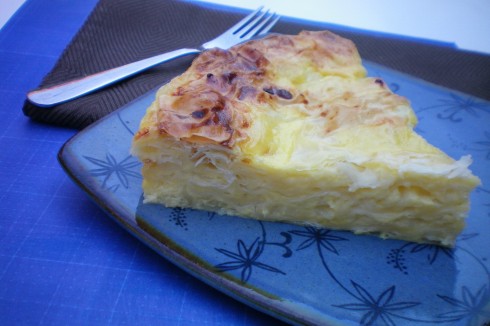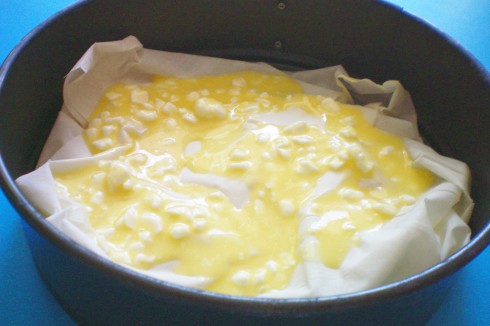 When most North Americans think of phyllo, Greek food usually comes to mind; spanakopita, bougatsa, baklava, and various other turnovers and pies that are eaten all over the Greek Isles. But phyllo pastry is popular throughout the Balkans, in Slavic cuisines, as well as in the Middle East. From Armenia to Turkey, phyllo stuffed pastries can be found alongside breakfast, lunch, or dinner, or simply enjoyed as snack food.
When most North Americans think of phyllo, Greek food usually comes to mind; spanakopita, bougatsa, baklava, and various other turnovers and pies that are eaten all over the Greek Isles. But phyllo pastry is popular throughout the Balkans, in Slavic cuisines, as well as in the Middle East. From Armenia to Turkey, phyllo stuffed pastries can be found alongside breakfast, lunch, or dinner, or simply enjoyed as snack food.
One of my favorite versions is this cheese pie eaten throughout the regions of the former Yugoslavia. I always looked forward to the nights when my mother was too tired to make a three course meal and baked this pie, serving it with a simple salad. She always had phyllo dough on hand. Layered with eggs and cheese and baked for half an hour, it was a quick dinner that also tasted great leftover for breakfast.
We’re lucky, my mother and I, because whenever we yearn to make this pie all we have to have to do is go to the corner store and pick up a package of the flaky pastry and we’re halfway to dinner. Not too long ago, the woman in my family had to make the phyllo dough from scratch because it wasn’t available in the shops. If you haven’t seen anyone make phyllo before, it’s a truly fascinating yet laborious process. I used to watch my Aunt Maria with awe as she stretched the dough across the whole length of the dining room table, coaxing it down over the edges, until it was so thin you could see through it. She would then rub it lovingly with olive oil until it gleamed like white satin. The baked product result was amazing, crispy and bubbling, with silky soft layers in between–almost like a rustic puff pastry. Now that supermarket phyllo is available everywhere in Serbia, no one bothers making it anymore. I’m sad to say that this store-bought phyllo is the same kind you can buy here, and its in no way comparable to the real deal. If you ever get a chance to try real homemade phyllo, you will know what I mean.
I plan to make my own phyllo one day. I’m psyching myself up for it. I have a recipe for Cretan phyllo from Aglaia Kremezi’s wonderful book The Food of the Greek Isles. It’s a modern version, requiring a food processor. Although the recipe says to roll the dough out as thinly as possbible, nowhere does it say it has to be six feet long, like your kitchen table! Perhaps I can convince my mother to give me a tutorial. I’m going to let you know how it goes.
For now, I’m going to keep making this cheese pie whenever I have an extra ten mintues and some phyllo leaves in the freezer.
Balkan Style Cheese Pie
Ingredients:
1/2 pound (500g) cottage cheese
1/2 pound (500g) feta cheese, crumbled
3 eggs
1/2 cup (150ml)club soda
1/4 cup (75ml) olive or canola oil
1 teaspoon salt (optional)
8 phyllo leaves
You can omit the salt if you find the mixture salty enough from the feta. I personally like this pie on the salty side. The club soda helps make the pie light and puffy.
Directions:
1) In a large bowl mix together the cheese, eggs, club soda, oil, and salt with a spatula until well combined.

2) Grease a 9-inch pie pan or spray with non-stick cooking spray. Place two sheets of phyllo, one crossed over the other, over the pan and gently tuck in. With a ladle, spoon over some of the cheese mixture.
Like this:

3)Fold the corners of the phyllo over the filling.

4) Pour over some more of the cheese mixture.

5) Repeat twice, alternating the phyllo leaves with the cheese mixture. Pour any leftover filling over top layer.
Like this:

6) Bake at 375F for about 30 minutes, or until top is golden and pie has puffed up.

6) Cool until lukewarm and serve.

In Balkan countries, this cheese pie is often eaten with plain yogurt. You can serve it for breakfast with some fruit, or alongside a salad for a light meal.
For variation, sprinkle layers with fresh spinach leaves, sauteed mushrooms, or browned ground lamb or pork.
Some notes on working with phyllo:
* Defrost phyllo overnight in the refrigerator for best result. Bring to room temperature before using.
*Do not remove the phyllo leaves from the plastic packaging until you are ready to use them, or they will dry out.
*Phyllo dries out very easily. While you are working, cover the unused sheets with a damp tea towel to prevent them from drying out.
*Phyllo is fragile but forgiving. In this dish it doesn’t matter if you tear the leaves. Also, in most recipes tears or breaks don’t matter on the inside layers. Any large holes can be patched with pieces of dough and then brushed with melted butter before shaping and baking.

















1 comment
Comments feed for this article
May 4, 2009 at 11:37 AM
sangeeta khanna
this looks fabulous ….very flaky n the layers look so good in the photo…i must try that.